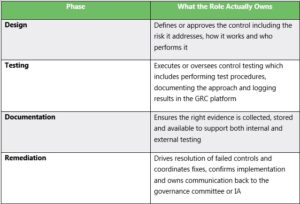Second Line Ready: What Real SOX Execution Looks Like and Why Many Teams Struggle
Never miss a thing.
Sign up to receive our insights newsletter.

Most SOX programs don’t blow up. They drift. They hit delays. Items fall through the cracks. Remediations stall. Deadlines pile up. By the time the external audit begins, the stress kicks in, and it’s too late to fix things cleanly.
These aren’t catastrophic failures. They’re symptoms of SOX programs that run on effort and intent but lack structure, visibility and cross-functional discipline.
The good news? You don’t need to overhaul your entire approach. With the right governance model and execution rhythm, you can bring your SOX program back on track — even mid-year.
Why SOX Programs Drift and What It Really Costs
Missteps in SOX execution don’t always show up immediately. They compound over time, often under the surface, until they create real risk, real stress and real cost.
Disconnected Planning Cycles
SOX programs often fall out of sync because each team works on a different timeline. Finance scopes SOX controls in Q1. IT doesn’t see the impact until Q2. Internal audit is planning fieldwork before testing has even started. Without shared calendars and checkpoints, cross-functional coordination is more assumption than fact.
Ambiguous Ownership
Control failures often sit unresolved because no one’s sure who owns the fix. Is it the business? IT? Finance? Clarifying who owns each aspect of a control (design, testing, remediation) is essential. Without it, ownership defaults to whoever is loudest or most available.
Governance by Email
Too many SOX programs operate off email threads and hallway conversations. There’s no regular forum to discuss testing status, upcoming risks or unresolved findings. This can result in teams operating in silos and problems going unaddressed until they’re urgent.
Governance, Risk and Compliance (GRC) Tools as Filing Cabinets
Platforms like AuditBoard and Workiva offer powerful collaboration features, but most teams don’t use them fully. Instead, they update controls once a year, post testing results later and ignore dashboard workflows. The platform becomes a digital binder, not a driver of execution.
When that happens, the tool reflects a lagging indicator, not an execution engine. What good looks like is embedding these platforms into governance — using workflow triggers, real-time dashboards, automated reminders and integrated ownership mapping to drive alignment and accountability, not just document it.
Internal Audit Filling the Gaps
When process owners aren’t stepping up, internal audit often fills the void: chasing evidence, tracking remediation and validating fixes. However, this compromises independence and creates bottlenecks. Internal audit (IA) should be a strategic partner, not a cleanup crew.
The Hidden Costs of Poor Execution
When SOX execution drifts off course, the costs aren’t always obvious but they’re real.
- Time: Retesting, rework and last-minute remediation slow everyone down.
- Money: External auditors spend more time, flag more issues and dig deeper.
- Morale: Crunch periods and unclear expectations create friction and burnout.
- Trust: Leadership starts doubting the team’s readiness and reliability.
- Reputation: Control failures that should’ve been fixed quietly become audit committee talking points.
What Good Looks Like
A Monthly SOX Governance Committee
The foundation is a small, focused committee that meets monthly — not quarterly and not as needed. It includes leads from finance, IT, internal audit and high-risk operational areas. The agenda is simple:
- Testing status and blockers
- Open remediation and owner accountability
- Control design changes or risks
- Key milestone updates, such as walkthroughs, testing and year-end audit
Embedded Ownership Matrix with Clear Accountability
Strong SOX programs don’t just assign a generic control owner. They break down ownership by phase, so each part of the control lifecycle is clearly defined and assigned.
Here’s what good ownership looks like:

Rolling 90-Day Execution Window (Dynamic Timeline Management)
Rather than trying to manage SOX across the entire year at once, high-performing teams focus on a rolling 90-day window — a living view of what’s being tested, remediated and reviewed in the near term.
Think of it as a real-time project tracker embedded in your GRC tool. It shows:
- Key walkthroughs or audit deadlines
- Controls currently in test
- Controls scheduled for testing within the next 30-60 days
- Open remediations with due dates
- Tasks that are unassigned or behind schedule
This window shifts forward every month, consistently showing the next three months of execution activity. It lets teams prioritize resourcing, flag blockers early and reduce last-minute scrambles.
For example, in June, the dashboard might show:
- Two critical walkthroughs with no ownership confirmed
- 58 controls currently in testing
- 24 controls scheduled to begin by mid-July
- 11 overdue remediations targeted for August
Aligning with the External Auditor Early and Often
Even the best internal execution can go sideways if external alignment isn’t built in. Expectations vary not just between external audit firms but also between teams and partners within those firms.
The best programs avoid unnecessary battles by getting aligned early and maintaining transparency:
- Loop in the external audit team during Q1/Q2 planning
- Validate scope decisions and any significant control changes
- Share testing calendars and anticipated timing
- Proactively align on judgment areas, such as information produced by the entity (IPE), management review controls (MRCs) and segregation of duties (SoD)
- Discuss documentation and evidence expectations up front
You’re not handing over your program — you’re minimizing surprises. This collaboration saves everyone time and stress later.
How to Course-Correct Midyear
It’s not too late. Midyear is actually the perfect time to put this structure in place before Q3 testing and Q4 audit prep.
Step 1: Launch or Reinforce the Governance Committee
- Set a 30-minute monthly meeting
- Use a standing agenda: status, blockers, ownership, risk events
- Drive updates through your GRC dashboard
Step 2: Build (or Update) Your Ownership Matrix
- Map owners by phase
- Embed this directly into your workflow platform
- Use it to assign tasks, validate evidence and close findings
Step 3: Reset the Calendar in Rolling 90-Day Blocks
- Show what needs to be tested or remediated by August, October and December
- Identify gaps now, not during year-end crunch
- Make this calendar visible across teams
Step 4: Reconnect With Your External Audit Team
- Schedule a sync to walk through your revised calendar and priorities
- Confirm expectations for walkthroughs, evidence and testing support
- Flag any gray areas and set shared assumptions now
Closing Thoughts
Good SOX execution doesn’t happen by accident. It’s built with structure, rhythm and shared ownership. If your team is still relying on last year’s spreadsheet, ad hoc meetings and good intentions, now is the time to reset. You don’t need perfection, but you do need a plan and the discipline to run it.
Start with governance — clarify roles, align on timing and run SOX like the strategic, cross-functional operation it actually is. Looking to reset your SOX program mid-year? Contact us to see how we can support your goals.
©2025
Second Line Ready Series
This article is part of a series for professionals who govern, oversee or operate the second line — whether that means leading internal audit or SOX, owning key risks or serving as a strategic partner in finance or compliance. From CFOs and controllers to audit directors and risk managers, this series delivers practical strategies, emerging risk insights and real-world guidance to strengthen oversight, improve existing programs and position the second line as a value-added function within the business.
Coming soon:
- Second Line Ready: When to Rebuild and When to Right-Size?
